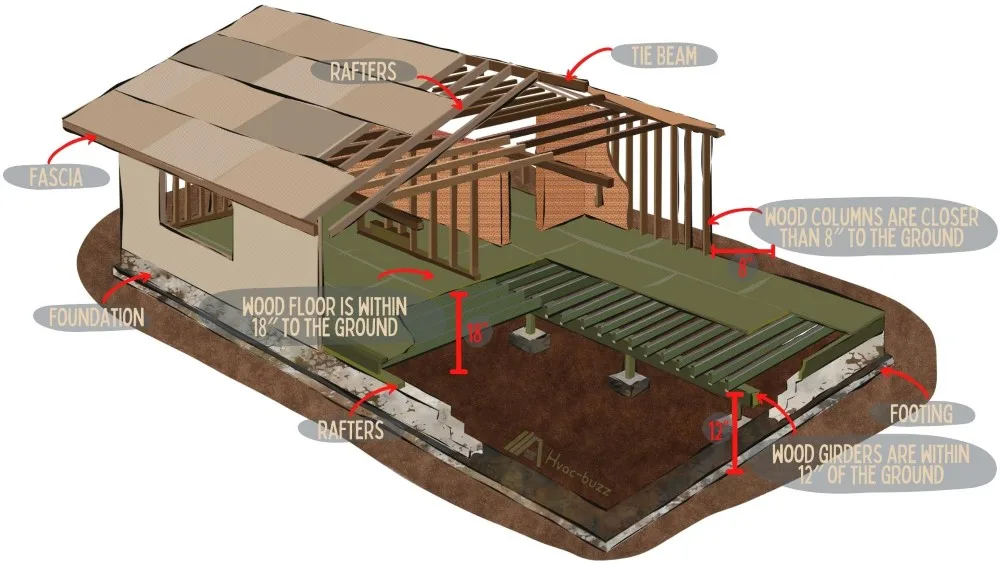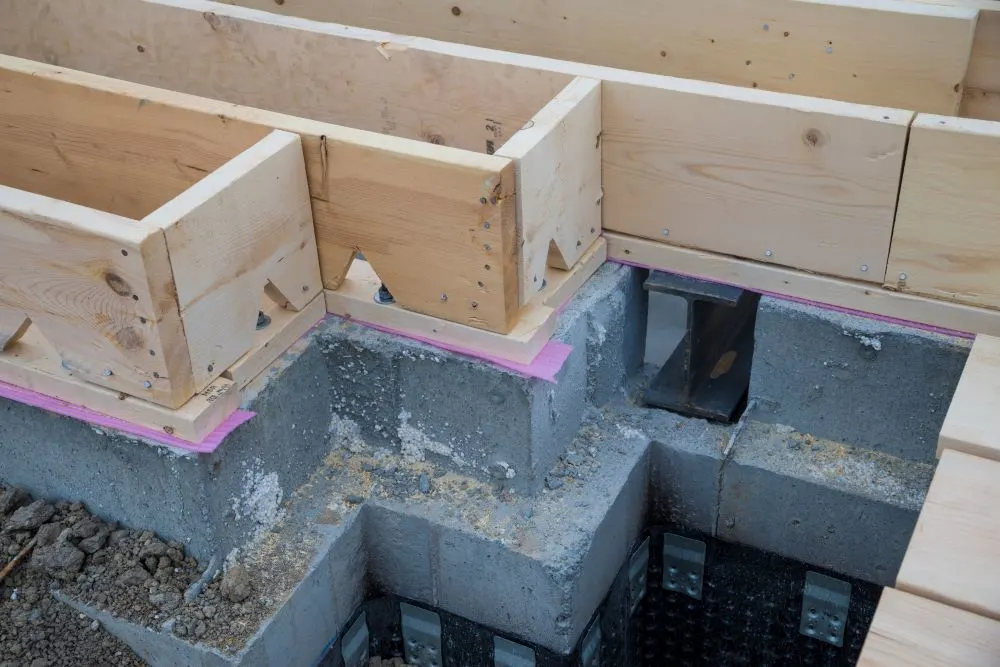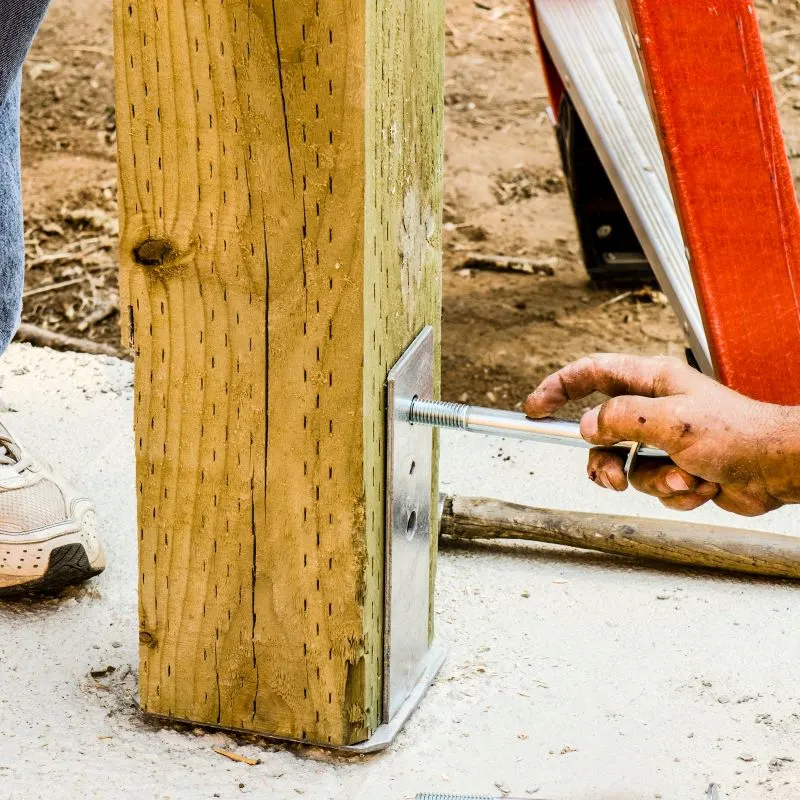Pressure-treated wood is controversial due to its treatment with chemical preservatives that are potentially harmful. Some argue that pressure-treated wood can be used throughout the home, while others fear this could be hazardous.
It’s important to be careful with your use of pressure-treated wood in your home. While it is required in some areas, it is not allowed in others. Pressure-treated wood must also meet a certain standard to be used safely within the home.

Pressure-treated wood can be used for interior framing. In some places, such as bottom plates and in sills and sleepers, it is required by code for the framing to be made from pressure-treated lumber. There are standards of pressure treatment aimed at ensuring safety from the chemicals used.
Pressure Treated Wood Can Be Used in Framing
Not only can you use pressure-treated wood for interior framing, but there are some locations where preservative-treated wood is actually required according to the residential building codes.
Locations Where Preservative Treated Wood Is Required
According to Section R317.1 of the International Residential Code (IRC), certain areas of the home, especially those that are susceptible to weather damage and pests and need to be durable in order to provide support, are required to consist of pressure-treated wood.
Within Crawl Spaces
Preservative treated wood is required in crawl spaces where the wood floor is within 18″ of the ground, where wood girders are within 12″ of the ground, and where wood columns are closer than 8″ to the ground.
The ground is going to be moist, and crawl spaces are often not well protected from the weather, so this makes pressure-treated wood essential in these areas.

To further protect the crawl space from moisture, many people install a vapor barrier, or go all out and encapsulate it. You can read about each of these and the differences between them in Differences Between Encapsulation and Vapor Barrier.
Structural Supports of Weather-Exposed Roofs or Decks
Pressure- or preservative-treated wood is required on wood framing that supports moisture-permeable floors or roofs. This is exempt when the roof or floor is separated from the framing by a moisture barrier.
Pressure-treated wood is highly durable and resistant to rot, making it necessary for withstanding possible wetness and weather damage to susceptible areas. Roofs and decks are both very vulnerable to water damage due to their direct exposure to the elements.
Sills/Sleepers
Pressure-treated lumber is required for sills and sleepers, which comprise framing that supports the flooring, where these sills and sleepers have direct contact with the ground. This requirement falls away if the wood frame is separated from the ground by a moisture barrier.
Flooring needs to be protected from dampness and infestation. Pressure-treated wood will keep pests and wetness from damaging your flooring’s support. If your flooring gets damaged it can start to squeak, so if your floors are squeaking, don’t just assume that it is normal.
Structural Support of Balconies and Porches
Preservative-treated wood is required in areas of interior framing that support balconies, porches, or buildings where their structural elements are exposed to weather outside without protection from the roof or eaves.
Areas that have the potential for water damage are ideal for pressure-treated lumber.

Basement Columns (if in Contact With Ground)
Basement columns that rest on the concrete floor require pressure-treated wood unless they are raised more than 1″ above the floor with a metal barrier and are separated from the metal barrier by a moisture barrier.
Basements are notorious for flooding, and they also need to be the structural support for the entire home above them. Pressure-treated wood withstands any dampness in the basement, which is susceptible to higher levels of humidity.
Using Pressure Treated Wood Throughout House
Pros
- Pressure-treated wood can be very affordable, more so than other naturally durable types of lumber. This type of lumber can come with 30-40% savings.
- It is highly durable, being resistant to scratches and dents. Pressure-treated wood will, therefore, last a long time.
- Insects and pests are not interested in pressure treated wood. This type of lumber is highly unappealing to termites and other insects since making a home there would result in their death by toxicity.
Cons
- Pressure-treated wood is treated with chemical preservatives, including copper, which is linked to the risk of cancer. However, the EPA does not deem pressure-treated wood harmful, so this is still up for debate.
- This lumber cannot be cut without proper protection, although Home Depot is happy to cut for you. Some see this as evidence that it is unsafe to use in the home.
- Pressure-treated wood cannot be used on countertops or tables. Some also fear that the chemicals used may seep out when used throughout the entire home and create an unsafe environment.
- It is highly flammable, making it a potential safety hazard. Additionally, the fumes from burned pressure treated wood contain toxins, so excess wood from home construction should not be burned unless by experts.
Anyone considering using pressure-treated lumber throughout their home must consider the benefits and disadvantages of this type of wood as well as the potential risks. Since pressure-treated wood is not deemed dangerous by the EPA, it is up to you to decide your opinion on the subject.
Should Pressure Treated Wood Be Used in Bathrooms?
Pressure-treated wood is great for bathroom floors and walls. Borate-treated wood is highly common for bathroom use because it has been deemed safe by the EPA and is highly durable in high moisture settings.
This type of lumber is often used for bathroom subflooring and places such as sills where termite infestations can be common.
Borate-treated lumber may not be completely risk-free since it is treated with chemicals, but some argue that it is safer than other types of preservative-treated wood since it’s a trace mineral found in our water.
Is It Hazardous in the Kitchen?
Experts advise against using pressure-treated wood anywhere where it will come into contact with food. This includes cutting boards or dining room tables. However, some people continue to use pressure-treated wood in the kitchen.
Pressure-treated wood can be used anywhere else in the interior other than places where food touches. This means that kitchen walls and floors are allowed.
Some may decide that having these chemicals in their kitchen seems like too much of a risk in case the chemicals leak from the wood. This is a singular decision as there is no regulation against its use in the space.
Allowable Grade of Pressure Treated Wood
There are standards for the grade of pressure-treated wood that can be used inside of homes for health and safety reasons. The AWPA standard is necessary since it includes intensive evaluation and continuous and large-scale data collection of lumber.
The IRC says lumber should meet AWPA U1 standards. This covers many varieties of pressure-treated wood, their use categories, and their allowable retentions of preservatives (measured in pounds per cubic foot of wood).
Interior use wood falls within the UC1 category (interior dry) and UC2 category (interior damp). UC1 and UC2 have the same retention levels for each of the preservative categories according to AWPA U1 standards.
ACQ- Type B or C
- Alkaline Copper Quarternary
- Retention of .25
ACQ- Type A or D
- Alkaline Copper Quarternary
- Retention of .15
CA-B
- Copper Azole- Type B
- Retention of .10
CA-C
- Copper Azole- Type C
- Retention of .060
Cu8
- Oxine Copper (Copper 8 Quinolinolate)
- Retention of .020
CuN-W
- Waterborne Copper Naphthenate
- Retention of .070
CX-A
- Copper HDO
- Retention of .206
EL2
- DCOI-Imidacloprid-Stabilizer
- Retention of .019
KDS
- Alkaline Copper Bentaine
- Retention of .19
MCA
- Micronized Copper Azole
- Retention of .060
MCA-C
- Micronized Copper Azole-Type C
- Retention of .050
PTI
- Propiconazole-Tebuconazole-Imidaloprid
- Retention of .013
PTI
- PTI plus Stabilizer
- Retention of .013
SBX
- Inorganic Boron (Formosan termites)
- Retention of .28
SBX
- Inorganic Boron (non-Formosan termites
- Retention of .17
Can I Use a Higher Grade of Treated Wood?
The main grades of pressure-treated wood include Premium, SS or Select Structural, Grade 1, Grade 2, and Grade 3.
Premium wood is the prettiest wood, containing no knots splits, or blemishes. This type of wood is generally Grade 1 or Grade 2 in terms of strength.
Select Structural is the strongest type of wood. It has few knots and blemishes but more than Premium. One knothole is allowable every 4 feet, and splits must be shorter than the width of the board.
Grade 1 lumber is stronger than Grade 2 and Grade 3. One knothole is allowable every 3 feet. Splits are allowable as long as they are not longer than the width of the board.
Grade 2 is weaker than all aforementioned lumber grades. Knotholes are allowable every 2 feet and may measure up to 3 1/2 inches in diameter. Splits may measure up to 1.5 times the width of the board.
Grade 3 is weaker with more imperfections than any of those mentioned above. It is not suited for anything but light framing where it will not be seen.
Grade 2 lumber is acceptable for all aspects of the interior including joists, rafters, sills, sleepers, and framing. Grade 1 is also acceptable for all of these aspects as well as being suited for more visible areas of the home, including decks, railings, and siding.
Higher grade wood will be more attractive and stronger, but it will also be more expensive. For the interior of a home, Grade 2 pressure-treated wood will perform well, and the use of Grade 3 should be limited.
You Cannot Use CCA-Treated Wood
CCA stands for chromated copper arsenate, which contains chromium, copper, and arsenic. Since arsenic is a highly toxic chemical, it is no longer used in homes since 2003. However, it is still produced for use in industrial settings due to its high protection against decay and insects, so be careful if you are sourcing secondhand lumber for your framing.
Ensuring the Quality of the Treated Wood
Pressure-treated wood is regulated for quality and must be marked and inspected by a licensed individual. This is specified within Section R317.2 of the IRC.
The IRC specifies that the wood must be approved according to the American Lumber Standard Committee. The inspection agency must be approved themselves and will mark the lumber with significant aspects of its treatment.
This includes the plant where it was treated, the preservative type used, the minimum preservative retention, the wood’s end use, the standard of its treatment, the inspection agency, and “dry” if it has been dried.
Special Fasteners and Connectors Required

Preservative treated wood must be attached with specific fasteners that, according to Section R317.3 of the IRC must be
“hot-dipped, zinc-coated galvanized steel, stainless steel, silicone bronze or copper.”
The IRC also specifies that steel bolts must have ½” or larger diameter and that:
“fasteners other than nails, staples and timber rivets shall be permitted to be of mechanically deposited zinc-coated steel with coating weights in accordance with ASTM B696, Class 55 minimum”.
Additionally:
“plain carbon steel fasteners in SBX/DOT and zinc borate preservative-treated wood in an interior, dry environment shall be permitted.”
These specifications are required because the chemicals in preservative-treated wood can be corrosive to certain types of metal. The permitted types of fasteners are resistant to corrosion.
Different types of chemicals used to treat wood can be less corrosive, which is why an exception is made for zinc borate treated wood that regular carbon steel fasteners are acceptable.
Alternatives to Pressure Treated Wood?
Certain types of decay-resistant lumber make good alternatives to pressure-treated wood that do not have any of the health risks associated with the chemical treatment.
These include white cedar, redwood, yew, tamarack, hemlock, and yellow cypress. However, these woods are not generally as durable as pressure-treated wood.
Furthermore, note that pressure-treated wood is required by code in areas of the home listed above. Alternatives are only to be used where this wood is not required.
For non-structural uses, such as decks, plastic and composite lumber are great alternatives to pressure-treated wood.
If you are framing your basement, then an alternative to using pressure-treated wood would be to install the framing with a 4″ gap between the wood and the masonry wall.
Sources
https://www.lyonslumber.com/when-to-use-pressure-treated-lumber-and-when-to-avoid-it
https://www.makefromwood.com/can-i-use-pressure-treated-lumber-inside-my-home/
https://www.fpl.fs.fed.us/documnts/techline/whats-in-that-pressure-treated-wood.pdf
https://www.panna.org/sites/default/files/imported/files/GRCAlternatives2TreatedWood.pdf


